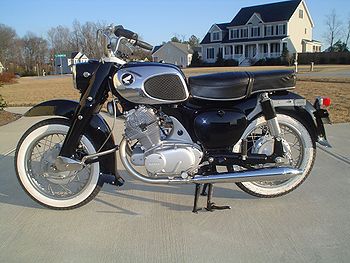Honda Dreams
Honda C71, C76, C72, C77 Dream[edit | edit source]
The Honda C72 & CA72 (and the identical C77/CA77 bikes with 305cc capacity) were first larger-capacity motorcycles that Honda mass-exported, and were significant motorcycles of their time. They not only introduced Honda as a brand to be reckoned with, but were the first 'proper' motorcycles to emerge from Japan. They were characterised by a pressed steel frame and alloy overhead cam twin cylinder engines, and were very well equipped, with 12v electrics, electric starter, indicators, dual seats and other advanced features, not common to most motorcycles of the period.
The bike that eventually became the C72/C77 started out as the Honda C70 Dream. Soichiro Honda had dubbed many of his earlier bikes 'Dream' after his dream of building complete motorcycles, and the new bike followed this naming pattern.
The C70 was a 250cc pressed-frame bike (very similar frame to the later bikes) released in 1956, and was called the Dream for the Japanese market. It was usually seen with a single seat & rack, with clip-on pillion pad. It was a well-equipped bike. The C75 was the 305cc version. They had a square head-light & shocks, leading link forks, pressed-steel handlebars and were somewhat unusual in appearance. The engine was dry sumped, and had 6v electrics. The design of both the frame and engine was heavily influenced by bikes built by NSU Motorenwerke AG, which Soichiro Honda had seen on his visit to Europe in 1955, including the Isle of Man TT races.
The C71/C76 were later developments, from 1957 or '58 onwards. The C71 was the 250cc bike, while the C76 was 305cc. Not much had changed visually, but they were fitted with electric starters. Dual seats were common on export bikes, but the single seat/rack combination was available. They were exported to Europe & the US, and other markets. A C71 was shown in the Netherlands in 1958 , and shown at the Earls court show in either 1958 or 1959, while the C76 became the flag-ship bike for the Honda range released into the US in 1959. A 1960 C76 is shown below:
There was a version built for the US market called the CA76, which came equipped with conventional tubular handlebars, but the standard pressed-steel bar C71 & C76 were also sold in the US. In the end, only a small handful were exported around the world, with most people wary of these unusually styled bikes from Japan. These were the first of the Honda 'Dreams' sold outside of Japan. Also available was the 'Dream Sport' bikes with high exhaust pipes, the CS71/CS76 & CSA71/CSA76. All sold well in their home market, and have attained cult-status amongst Japanese collectors.
The CE71 Dream Sport is a closely related version, and very rare. The dry-sumped engine, in the same pressed frame, with tubular handlebars, low sports exhaust pipes & dual seat, with an angular fuel tank similar to the CB92. They were exported to the US & Europe, a bit over 400 were made & they were all recalled, with most scrapped. A few survive.
Another rare version was the CB71 - another sports version of the dry sump bikes. It was only available in Japan, and it seems only in limited numbers. It was very reminiscent of the CB92 - pressed frame, flat 'ace' handlebars, fly screen, low megaphone exhaust pipes, cut down rear mudguard, cycle-style front guard, angular fuel tank with the 'wrap-over' rubber kneepad of the CB92. It was possibly a special-order racing-only bike.
The final development of these bikes was a significant one - the C72/C77 was available from 1960, and the American market CA72/CA77 was available in 1961, although a 1960 C72/C77 would be a very rare bike, most came out in 1961 too. These bike were made until 1967, although it seems that because of the way US bikes are dated, many are referred to in the US as 1968 or even 1969 models.
These bikes saw a completely redesigned engine - a wet-sump engine with many internal differences, essentially a new motor, with electric start & 12v system.
As before, the C72/77 had pressed steel handlebars & the CA72/77 had high tubular bars, beyond that there were only detail difference, mainly, indicators were fitted to non-US bikes & different indicators were fitted to German bikes, to suit their laws. Bikes built up to 1963 had a different fuel tank shape to later bikes, and the pressed steel bars were discontinued at about the same time (all models using conventional tubular bars) but otherwise the bike stayed much the same for the rest of it's run. There was also a version of the bike called the C78/CA78, but visually there were no substantial differences to the C77/CA77.
As before these bikes were considered as well-equipped touring/commuter bikes - not particularly sporting, but reliable and comfortable, with a turn of speed much better than many larger-capacity bikes.
Like the earlier dry-sump bikes, there were high-exhaust sports version, the CS72 & CS77, and the corresponding American market CSA72 & CSA77. A CS72 is shown below:
The C72/C77 was exported to Europe, Britain, Australia & other markets, and sold in some numbers, although as it was comparatively expensive, not as well as hoped. Post-WW2 anti-Japanese sentiment was still rife, and in the UK, manufacturers like BSA & Triumph attempted to blackmail dealers into not selling Japanese bikes. Also, the style was considered to be somewhat unusual to European eyes, and by the mid-1960's quite old-fashioned in appearance.
A re-development of the engine was used in the seminal CB72 & it's 305cc cousin, the Honda CB77, both of which were ground-breaking sports motorcycles of their day. The CL72 & CL77 Scramblers also used the same engines. In addition, the engine was studied, and developed & enlarged by the Laverda factory as the basis of their 650cc & 750cc twin cylinder engines.
